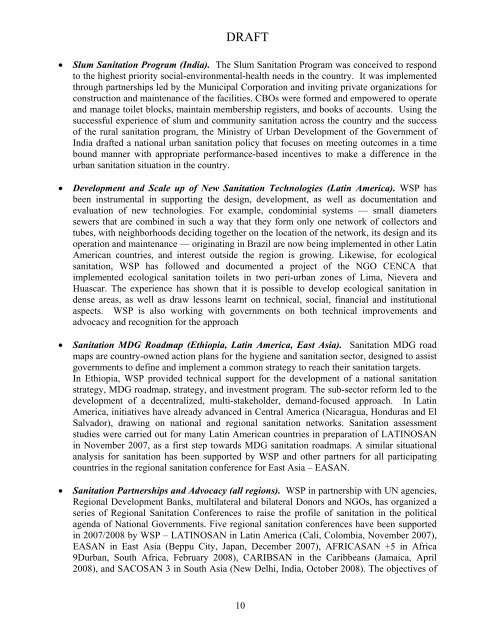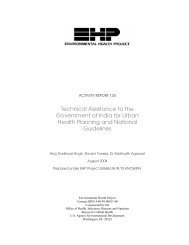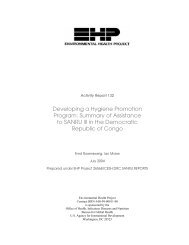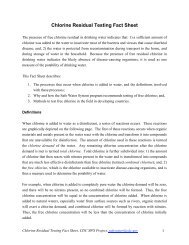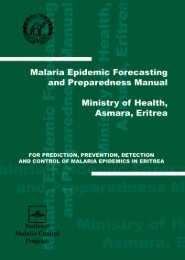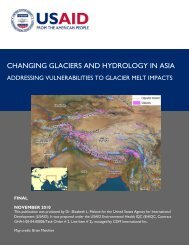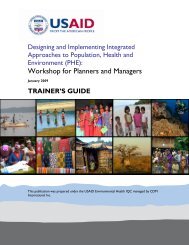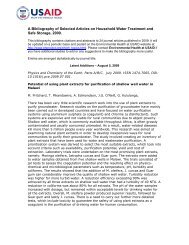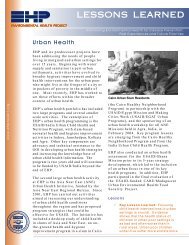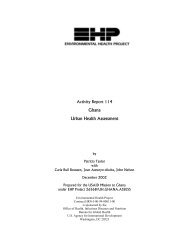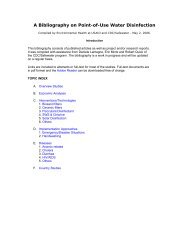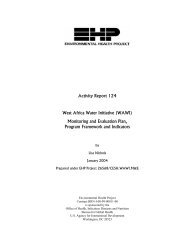The Water and Sanitation Program - Environmental Health at USAID
The Water and Sanitation Program - Environmental Health at USAID
The Water and Sanitation Program - Environmental Health at USAID
You also want an ePaper? Increase the reach of your titles
YUMPU automatically turns print PDFs into web optimized ePapers that Google loves.
DRAFT• Slum <strong>Sanit<strong>at</strong>ion</strong> <strong>Program</strong> (India). <strong>The</strong> Slum <strong>Sanit<strong>at</strong>ion</strong> <strong>Program</strong> was conceived to respondto the highest priority social-environmental-health needs in the country. It was implementedthrough partnerships led by the Municipal Corpor<strong>at</strong>ion <strong>and</strong> inviting priv<strong>at</strong>e organiz<strong>at</strong>ions forconstruction <strong>and</strong> maintenance of the facilities. CBOs were formed <strong>and</strong> empowered to oper<strong>at</strong>e<strong>and</strong> manage toilet blocks, maintain membership registers, <strong>and</strong> books of accounts. Using thesuccessful experience of slum <strong>and</strong> community sanit<strong>at</strong>ion across the country <strong>and</strong> the successof the rural sanit<strong>at</strong>ion program, the Ministry of Urban Development of the Government ofIndia drafted a n<strong>at</strong>ional urban sanit<strong>at</strong>ion policy th<strong>at</strong> focuses on meeting outcomes in a timebound manner with appropri<strong>at</strong>e performance-based incentives to make a difference in theurban sanit<strong>at</strong>ion situ<strong>at</strong>ion in the country.• Development <strong>and</strong> Scale up of New <strong>Sanit<strong>at</strong>ion</strong> Technologies (L<strong>at</strong>in America). WSP hasbeen instrumental in supporting the design, development, as well as document<strong>at</strong>ion <strong>and</strong>evalu<strong>at</strong>ion of new technologies. For example, condominial systems — small diameterssewers th<strong>at</strong> are combined in such a way th<strong>at</strong> they form only one network of collectors <strong>and</strong>tubes, with neighborhoods deciding together on the loc<strong>at</strong>ion of the network, its design <strong>and</strong> itsoper<strong>at</strong>ion <strong>and</strong> maintenance — origin<strong>at</strong>ing in Brazil are now being implemented in other L<strong>at</strong>inAmerican countries, <strong>and</strong> interest outside the region is growing. Likewise, for ecologicalsanit<strong>at</strong>ion, WSP has followed <strong>and</strong> documented a project of the NGO CENCA th<strong>at</strong>implemented ecological sanit<strong>at</strong>ion toilets in two peri-urban zones of Lima, Nievera <strong>and</strong>Huascar. <strong>The</strong> experience has shown th<strong>at</strong> it is possible to develop ecological sanit<strong>at</strong>ion indense areas, as well as draw lessons learnt on technical, social, financial <strong>and</strong> institutionalaspects. WSP is also working with governments on both technical improvements <strong>and</strong>advocacy <strong>and</strong> recognition for the approach• <strong>Sanit<strong>at</strong>ion</strong> MDG Roadmap (Ethiopia, L<strong>at</strong>in America, East Asia). <strong>Sanit<strong>at</strong>ion</strong> MDG roadmaps are country-owned action plans for the hygiene <strong>and</strong> sanit<strong>at</strong>ion sector, designed to assistgovernments to define <strong>and</strong> implement a common str<strong>at</strong>egy to reach their sanit<strong>at</strong>ion targets.In Ethiopia, WSP provided technical support for the development of a n<strong>at</strong>ional sanit<strong>at</strong>ionstr<strong>at</strong>egy, MDG roadmap, str<strong>at</strong>egy, <strong>and</strong> investment program. <strong>The</strong> sub-sector reform led to thedevelopment of a decentralized, multi-stakeholder, dem<strong>and</strong>-focused approach. In L<strong>at</strong>inAmerica, initi<strong>at</strong>ives have already advanced in Central America (Nicaragua, Honduras <strong>and</strong> ElSalvador), drawing on n<strong>at</strong>ional <strong>and</strong> regional sanit<strong>at</strong>ion networks. <strong>Sanit<strong>at</strong>ion</strong> assessmentstudies were carried out for many L<strong>at</strong>in American countries in prepar<strong>at</strong>ion of LATINOSANin November 2007, as a first step towards MDG sanit<strong>at</strong>ion roadmaps. A similar situ<strong>at</strong>ionalanalysis for sanit<strong>at</strong>ion has been supported by WSP <strong>and</strong> other partners for all particip<strong>at</strong>ingcountries in the regional sanit<strong>at</strong>ion conference for East Asia – EASAN.• <strong>Sanit<strong>at</strong>ion</strong> Partnerships <strong>and</strong> Advocacy (all regions). WSP in partnership with UN agencies,Regional Development Banks, multil<strong>at</strong>eral <strong>and</strong> bil<strong>at</strong>eral Donors <strong>and</strong> NGOs, has organized aseries of Regional <strong>Sanit<strong>at</strong>ion</strong> Conferences to raise the profile of sanit<strong>at</strong>ion in the politicalagenda of N<strong>at</strong>ional Governments. Five regional sanit<strong>at</strong>ion conferences have been supportedin 2007/2008 by WSP – LATINOSAN in L<strong>at</strong>in America (Cali, Colombia, November 2007),EASAN in East Asia (Beppu City, Japan, December 2007), AFRICASAN +5 in Africa9Durban, South Africa, February 2008), CARIBSAN in the Caribbeans (Jamaica, April2008), <strong>and</strong> SACOSAN 3 in South Asia (New Delhi, India, October 2008). <strong>The</strong> objectives of10


